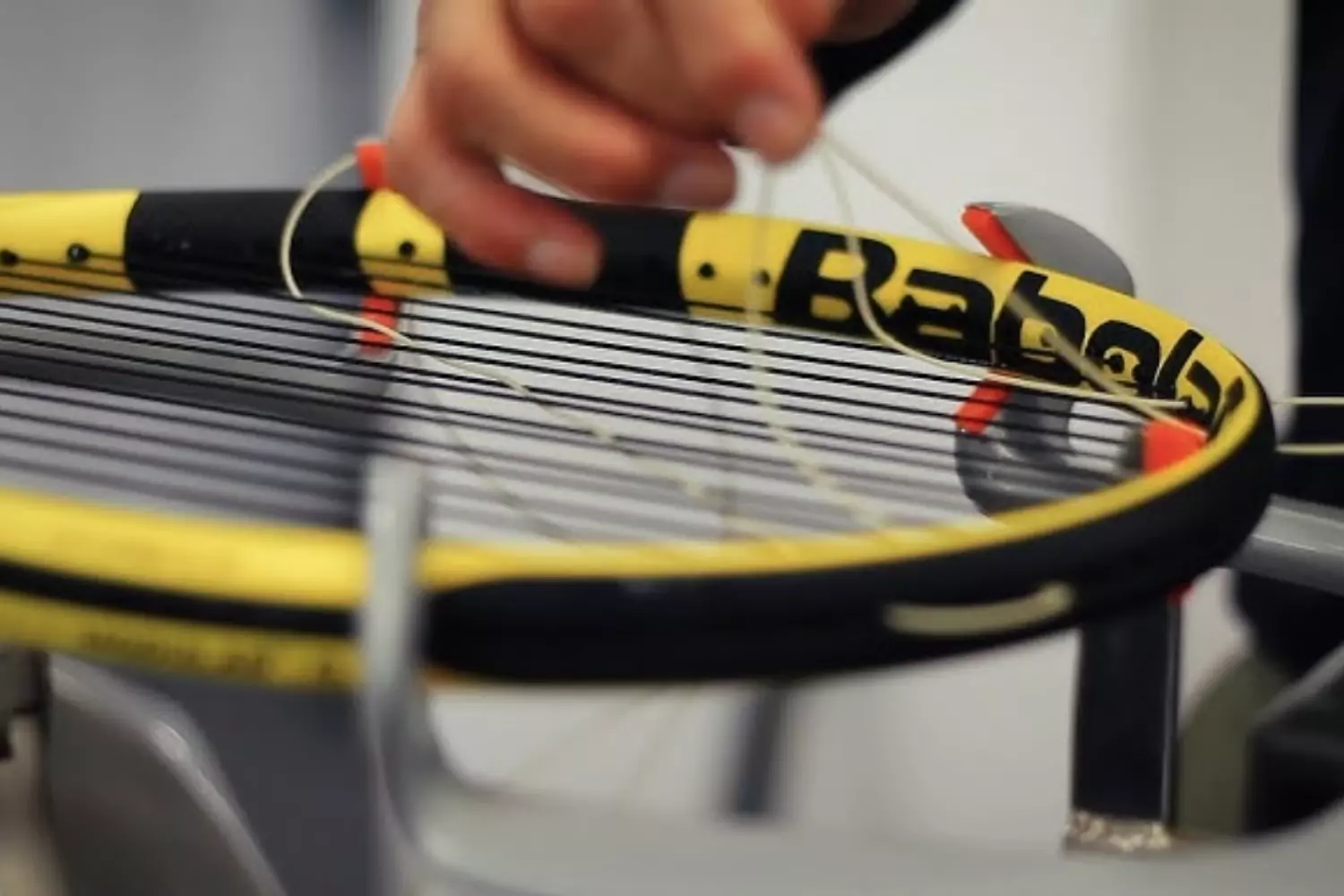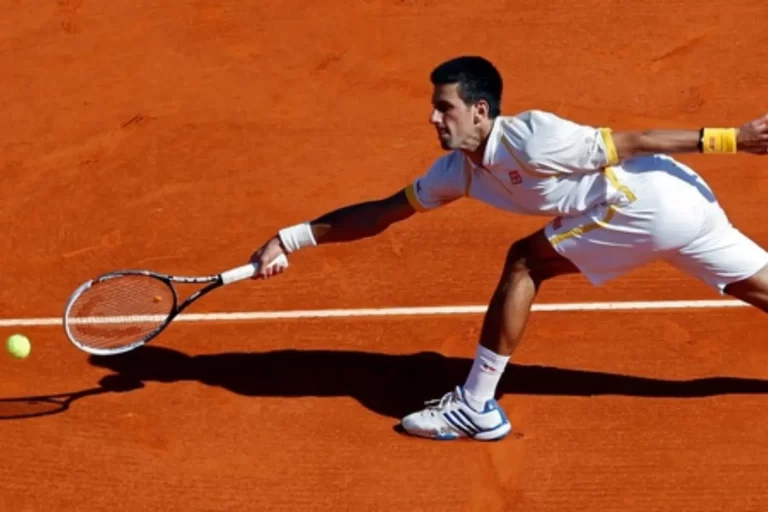The Best Tennis String Tension Finding Guide

To begin with, choosing the tension of your tennis racket can be a little daunting.
Tennis players are often left confused and no closer to understanding tension choice after a quick online search, often revealing a staggering number of possible tennis string tensions.
Several years of experience experimenting with a variety of tensions and gauges (thicknesses) across a multitude of string types informed this article.
In terms of tension range and natural gut, multifilaments, and polyesters, we’ve tried them all!
This document will enable you to make an informed decision regarding string tension, and you might even be able to converse with your local stringer on a jargon level afterward!
Angular string tension refers to how tight the strings are wound around the frame of the racket. It can be measured in pounds or kilograms.
Make sure your stringer knows what unit measurement you prefer, rather than just stating one!
You are likely to be assumed to mean pounds, however, by most stringers.
Tensions typically range from 40-65 pounds, but most players’ tensions fall within these ranges!
Professional stringers generally recommend stringing rackets as low as possible while still maintaining control of the ball.
Let’s start by looking at low tension.
Low String Tension
Tennis String tensions between 40 and 50 pounds are considered low.
Exceptions do exist, however, and some players go as low as 40 pounds!
At the other end of the spectrum, we have trampolines, and we’ll discuss them later.
But first, let’s establish some facts.
A low-tension racket stringing will provide you with:
- MORE Power
- MORE SPIN
- LESS Control
- MORE Durability
- MORE FEEL
- MORE COMFORT
It is important to consider your game’s needs and how you want your racket to perform before deciding on string tension.
The tension of a racket that is wielded by a player who is strong and powerful will probably be higher than that of a racket that is weak and weak.
In what way?
Their natural power is already great, so lowering the tension and thereby increasing the elastic trampoline effect would likely send the ball flying!
Alternatively, a lower-level club player who isn’t as powerful might benefit immensely from a low-string tension.
It would be great if they could access true power through their strokes, which is not fully developed yet, so this choice of tension would be a welcome boost!
The feel of your racket is another important consideration.
Those who suffer from wrist and arm injuries should avoid high tension and instead string their rackets low.
The result will be greater comfort as well as an increased sweet spot – an added advantage!
A player who prefers to play with a lower tension will love the pocketing effect, but a player who prefers to play with a higher tension will most likely dislike it and thirst for control.
Take a look at McEnroe and Roddick! There was a low string for John and a high string for Andy!
You’ll also be able to hit heavier balls if you string your tennis racket at a low tension.
It happens because the ball can pocket deeply into the string bed, causing the string bed to snap back more rapidly, causing the ball to be launched back with more RPMs than when tensioned higher.
High String Tension
If a tennis string tension is high, it would be 55 pounds to 65 pounds.
It’s important to note that some players opt for even higher tension levels – similar to what we discussed during the low-tension section.
You shouldn’t go over 60 pounds unless you want to injure yourself.
Rackets that are strung this tight, unless they are natural gut, lose a lot of their properties.
If this is the case, it would be better to rethink your string or even racket selection.
An excellent choice of higher tension would be between 55 lbs and 60 lbs. In addition to giving you power, this will also give you a lot of control.
Using high tension on your tennis racket has some benefits and drawbacks:
- LESS Power
- LESS Spin
- MORE Control
- LESS Durability
- LESS Feel
- LESS Comfort
That list may make you wonder, what’s the point?
That’s exactly right, as it has a lot of “LESSES”!
In any case, as we mentioned a little earlier, stringing high is only appropriate for a very specific type of player.
Buying polyester string means you’re getting a racket and string that are as powerful, probably tall, and aggressive as Del Potro.
The extra power he gains from his equipment will actually result in diminishing returns since he hits his forehand bigger than most people can serve.
A del Potro ball should bounce on the court, not burn a hole through the back fence.
Stringing really high can result in the string losing a lot of its elastic properties.
Using polyester strings at tensions over 60 lbs damages their properties and adversely affects their performance, according to TheTennisBros.com.
Except if you’re used to hitting with wooden planks, the comfort level is also going to be pretty bad.
You should carefully consider whether stringing high with a polyester string is the right choice for you unless you have wrists of steel and are physically fit.
You may enjoy reading Serena Williams Racket And String
Multiple Rackets
It doesn’t take very long for you to spot a player swapping their racket for a new one whenever you turn on the tennis on TV.
Federer does this every time he changes balls, while others do it less often.
This might seem like the result of professionals snapping their strings so frequently, but it isn’t.
It usually happens when the string tension drops during point play.
The ball would land 10cm out when it previously landed 10cm in a match-play scenario.
During rallies, the pros deal with such fine margins that maintaining perfect precision (or as close to it as they can manage) throughout a match is crucial.
This tension loss is mostly prevented by Federer changing rackets so often.
It is also because of another reason.
In order to play their best, professionals have several rackets strung at different tensions (8-12 for pros) depending on the conditions.
High tension would be used if the weather was boiling hot.
In a sunny day, the air inside the ball becomes warmer, which causes the ball’s velocity to increase significantly.
As a result of the drop in ball velocity on a very cold day, players will play with a lower tension than usual.
A third reason for having multiple rackets, it enables the player to adjust the technique based on how the ball is being struck that day.
From a biomechanical standpoint, no two strokes can be identical to the fourth decimal place of the joint degree angle!
This is probably something you’ve experienced.
The ball may go a foot long even though you strike it very well some days.
A higher-tension racket would solve the issue and allow the ball to dive into the court in this situation, so just get another one out of your bag that’s strung up higher than the one you’re using.
It would be extremely expensive to do this!
Multiple restrings are mostly used by professionals.
Nonetheless, what’s to stop you from strung a racket higher and lower than the ones you already have?
You may enjoy reading Wilson Vs Babolat Tennis Rackets
Choosing the Right String Tension

Different players require different tennis string tensions.
In general, we don’t recommend copying the racket specifications of professional players, unless you possess flawless mechanics.
Even so, everyone has a different preference.
In general, we recommend starting at the low 50s and seeing how it goes.
Let’s use 53 pounds as an example. Additionally, keep in mind that tension loss will occur pretty quickly, and that 53lbs will become 48lbs pretty quickly!
All strings lose tension at some point, although some strings lose tension more quickly than others.
Your rackets’ stringing frequency will determine how close you are to your preferred number.
There will be some players who string every day, while others will only do it every 2 months or even less frequently.
String Tension by Type
A string’s tension will depend on what type of string it is, and there is a stark contrast between them.
On and off tour, co-polyester strings are the most popular string type today. Luxilon Alu Power or Babolat RPM Blast, for instance.
Due to their stiffness and low power, these strings require a lower tension than elastic multifilament strings for best control.
Polyester strings should be tensioned somewhere between 48 and 58 pounds.
Our gut strings, however, are natural.
Those strings can really give your shot some mph because they are among the strongest in the world.
To tame some of the extreme elasticity of these, you will need to string them higher in either a full or half bed.
The recommended tension for multifilament or natural gut strings is 55-62 pounds.
String Tension by Racket
As a result of this factor, I have made some stupid decisions in the past.
As an amateur player, I used to put natural gut in a 46-pound Babolat Pure Drive Tour Plus because I wanted to create as much power as possible.
It was a disaster waiting to happen.
As for the racket itself, it is an absolute rocket launcher, and the gut was a poor choice of string.
In no time at all, I decided to string the racket differently!
String tension should always be determined by the racket you are using.
Those with powerful rackets should string high in order to dilute some of their power, while those with low-powered rackets should string loosely.
Whenever you are playing with a low-power racket and a high-power string, find a happy medium.
Exceptions
To conclude this article, let’s look at some fun facts!
When you get your racket strung next time, I’ve provided some helpful guidelines, but there will always be those who don’t respond well to my suggestions.
The legendary black Wilson Pro Staff Pete Sampras used to string weighed 70 lbs!
The frame would crack under that strain!
The string-breaking he used to do during matches makes sense!
Obviously, Pete’s strategy worked, so you wouldn’t alter it.
It’s also worth pointing out that polyester strings were not invented during this era, so players had to find alternative methods of taming the natural gut.
A second extreme is represented by Jack Sock, an American.
Observe him play and you’ll immediately notice his forehand is unbelievably powerful – it’s one of the most potent weapons on tour.
The same is true for Jack’s Babolat Pure Aero; sometimes he strings it at 38lbs!
Jack’s tension is clearly improving the spin on his already heavy forehand, which I would probably dislike if I tried it.
Natural gut would never work with this low tension, because the ball would fly out of the park, however, Mr Sock’s string – Luxilon Alu Power – helps to balance the power.
Additionally, he has a full Western grip, which helps him make better contact with the ball.
A unique combination of spin, low tension, and “through the court” power makes him an extremely effective player.
Unless you feel brave, do not attempt these at home!
Conclusion: Tennis String Tension Finding Guide
In order to play well, you must choose the right racket. In order to get the most out of your racket, you need to carefully consider how you string it.
Tennisracketnet.com will take care of the hard work so you can get the most out of your racket setup. Your custom fitting includes three string recommendations tailored to your specific needs to increase your performance on the court.





